The focal lineages we chose represent a diverse group of taxa which have a variety of roles both trophically and ecologically in the forest ecosystem. We are using next-gen sequencing methods to collect data which we will use to answer some of our questions about community assembly and population structure (read more about population genomics here). You can find out more about these fascinating arthropods below.
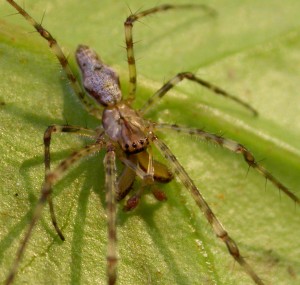 Tetragnathidae Tetragnatha spiders A spectacular example of adaptive radiation is shown in the Long-jawed orb-weaving spiders of the genus Tetragnatha (Tetragnathidae) in the Hawaiian Islands. Many species are web-building, with structural modifications of the abdomen that allow concealment within specific microhabitats. One entire lineage, the “spiny leg” clade, has abandoned web building and adopted a cursorial lifestyle. Over the last 20 years we have been conducting phylogenetic and phylogeographic assessments to determine affinities among different groups of Hawaiian Tetragnatha, and establish relationships to mainland congeners. Results to date indicate that: (1) Camouflage appears to have played a primary role in diversification of the “spiny leg” clade, with repeated evolution of similarly cryptic forms on different islands (Gillespie 2004). This suggests a major selective role of visual predation on the spiders as a primary axis of diversification. (2) Habitat specialization forms the basis of the adaptive radiation, with major changes (most notably the loss of web building behavior in one lineage) occurring at the base of the radiation (ref). Among those that have not lost webs, similar web forms have evolved repeatedly and independently (Blackledge & Gillespie 2005), although the one-to-one matching is less apparent.
Tetragnathidae Tetragnatha spiders A spectacular example of adaptive radiation is shown in the Long-jawed orb-weaving spiders of the genus Tetragnatha (Tetragnathidae) in the Hawaiian Islands. Many species are web-building, with structural modifications of the abdomen that allow concealment within specific microhabitats. One entire lineage, the “spiny leg” clade, has abandoned web building and adopted a cursorial lifestyle. Over the last 20 years we have been conducting phylogenetic and phylogeographic assessments to determine affinities among different groups of Hawaiian Tetragnatha, and establish relationships to mainland congeners. Results to date indicate that: (1) Camouflage appears to have played a primary role in diversification of the “spiny leg” clade, with repeated evolution of similarly cryptic forms on different islands (Gillespie 2004). This suggests a major selective role of visual predation on the spiders as a primary axis of diversification. (2) Habitat specialization forms the basis of the adaptive radiation, with major changes (most notably the loss of web building behavior in one lineage) occurring at the base of the radiation (ref). Among those that have not lost webs, similar web forms have evolved repeatedly and independently (Blackledge & Gillespie 2005), although the one-to-one matching is less apparent.
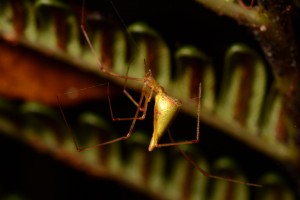 Theridiidae Ariamnes spiders (photo by Rosemary Gillespie) In the Hawaiian Islands, Simon (1900) recognized a single species each of Argyrodes (A. hawaiensis) and Ariamnes (A. corniger). The Argyrodes have recently been re-examined by Rivera (2010) and the Ariamnes by Gillespie & Rivera (Gillespie and Rivera 2007). The former comprise few species, all ecologically similar and obligate kleptoparasites on the webs of the large sheet web spider, Orsonwelles spp (Araneae, Linyphiidae) (Hormiga 2002). The latter is ecologically diverse, comprising > 11 species that appear to be facultatively kleptoparasitic, more commonly observed as free living (Gillespie and Rivera 2007). These spiders demonstrate discrete ecomorphs, “Short moss”, “White lichen”, “Gold leaf”, and “Dark”.
Theridiidae Ariamnes spiders (photo by Rosemary Gillespie) In the Hawaiian Islands, Simon (1900) recognized a single species each of Argyrodes (A. hawaiensis) and Ariamnes (A. corniger). The Argyrodes have recently been re-examined by Rivera (2010) and the Ariamnes by Gillespie & Rivera (Gillespie and Rivera 2007). The former comprise few species, all ecologically similar and obligate kleptoparasites on the webs of the large sheet web spider, Orsonwelles spp (Araneae, Linyphiidae) (Hormiga 2002). The latter is ecologically diverse, comprising > 11 species that appear to be facultatively kleptoparasitic, more commonly observed as free living (Gillespie and Rivera 2007). These spiders demonstrate discrete ecomorphs, “Short moss”, “White lichen”, “Gold leaf”, and “Dark”.
 Drosophilidae Drosophila flies (photo by Karl Magnacca) Hawaiian flies, family Drosophilidae, have undergone explosive adaptive radiation in the Hawaiian Islands. Females oviposit eggs in either fungi, flowers, fruits, leaves, stems, bark, sap fluxes, or other novel substrates. Varied selective forces in these alternative breeding sites appear to have molded female reproductive characters and strategies into diverse outcomes. Analysis of shifts in breeding substrate, and the associated evolution of selected ovarian, egg, and ovipositor traits has shown strong historical associations among female reproductive traits and between particular traits and the breeding substrate. It appears that the ecological diversification in breeding substrates has been an integral component in the radiation of drosophilids in Hawai’i
Drosophilidae Drosophila flies (photo by Karl Magnacca) Hawaiian flies, family Drosophilidae, have undergone explosive adaptive radiation in the Hawaiian Islands. Females oviposit eggs in either fungi, flowers, fruits, leaves, stems, bark, sap fluxes, or other novel substrates. Varied selective forces in these alternative breeding sites appear to have molded female reproductive characters and strategies into diverse outcomes. Analysis of shifts in breeding substrate, and the associated evolution of selected ovarian, egg, and ovipositor traits has shown strong historical associations among female reproductive traits and between particular traits and the breeding substrate. It appears that the ecological diversification in breeding substrates has been an integral component in the radiation of drosophilids in Hawai’i
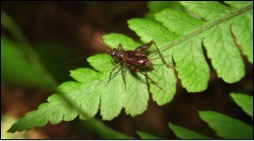 Gryllidae Laupala crickets (photo by Kerry Shaw) Hawaiian crickets of the genus Laupala (family Gryllidae), with 37 described species, is one group of cryptic species in which the taxonomic recognition of behavioural traits has led to a significant increase in the number of species hypothesized. These small, forest-dwelling crickets found throughout the archipelago display diversity in acoustic phenotypes.
Gryllidae Laupala crickets (photo by Kerry Shaw) Hawaiian crickets of the genus Laupala (family Gryllidae), with 37 described species, is one group of cryptic species in which the taxonomic recognition of behavioural traits has led to a significant increase in the number of species hypothesized. These small, forest-dwelling crickets found throughout the archipelago display diversity in acoustic phenotypes.
Nitidulid Eupetinus & Prosopeus beetles (photo by George Roderick) Nitidulids are small sap-feeding feeding beetles. The native species of Hawaiian Nitidulidae are primarily saproxylic, larvae and adults feed on micro fungi growing on the host plant. Larvae and adults of the majority of endemic Hawaiian nitidulids are associated with decaying plant material and the substrate may be partitioned by structure and over time, with one speci es active within the resource in an early state of decay and a different species in the later stages. Adults and larvae are often found together, with many adults of flower inhabiting species consuming pollen in addition to fungi. Resource use patterns among species in a given lineage are correlated with the level of diversity for a given lineage. The more speciose lineages contain species utilizing a wide range of plants and substrates and lineages utilizing few resources and substrate types have few species. Species of Prosopeus, Orthostolus, Gonioryctus, Apetasimus, and Eupetinus are associated with Campanulaceae. Araliaceae are associated with species in the genera Prosopeus, Eupetinus, and Gonioryctus, with the latter genus having radiated extensively in the subcortical habitat.
es active within the resource in an early state of decay and a different species in the later stages. Adults and larvae are often found together, with many adults of flower inhabiting species consuming pollen in addition to fungi. Resource use patterns among species in a given lineage are correlated with the level of diversity for a given lineage. The more speciose lineages contain species utilizing a wide range of plants and substrates and lineages utilizing few resources and substrate types have few species. Species of Prosopeus, Orthostolus, Gonioryctus, Apetasimus, and Eupetinus are associated with Campanulaceae. Araliaceae are associated with species in the genera Prosopeus, Eupetinus, and Gonioryctus, with the latter genus having radiated extensively in the subcortical habitat.
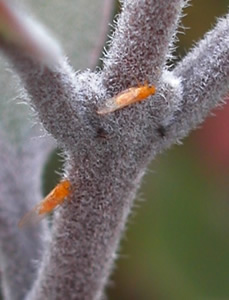 Psyllidae Trioza & Kuwayama (photo by Diana Percy) The Hawaiian Metrosideros-feeding psyllids have undergone a complex radiation in the Hawaiian Islands with free-living and galling psyllids derived from within the same lineage. Gall type is diverse, constituting an extended phenotype central to the radiation. Shifts to different gall types appears to have been key to the diversification of this insect group. The same or similar gall shifts seem to have occurred multiple times on different islands. Similar shaped flat leaf galls, stem and bud galls, are found on all islands, but other gall types only occur on one island. Speciation has also occurred, with shifts to different geographic regions while retaining the same galling biology (both within and between islands). Psyllids are small sap-feeding herbivores that exhibit unusually high levels of host specificity. Preliminary molecular dating analysis suggest that the Metrosideros-feeding group arrived soon after the colonization of the Hawaiian Islands by Metrosideros and therefore insect and plant diversification may have similarly timed historical processes providing an excellent study system to investigate the mechanisms of insect-plant codiversification.
Psyllidae Trioza & Kuwayama (photo by Diana Percy) The Hawaiian Metrosideros-feeding psyllids have undergone a complex radiation in the Hawaiian Islands with free-living and galling psyllids derived from within the same lineage. Gall type is diverse, constituting an extended phenotype central to the radiation. Shifts to different gall types appears to have been key to the diversification of this insect group. The same or similar gall shifts seem to have occurred multiple times on different islands. Similar shaped flat leaf galls, stem and bud galls, are found on all islands, but other gall types only occur on one island. Speciation has also occurred, with shifts to different geographic regions while retaining the same galling biology (both within and between islands). Psyllids are small sap-feeding herbivores that exhibit unusually high levels of host specificity. Preliminary molecular dating analysis suggest that the Metrosideros-feeding group arrived soon after the colonization of the Hawaiian Islands by Metrosideros and therefore insect and plant diversification may have similarly timed historical processes providing an excellent study system to investigate the mechanisms of insect-plant codiversification.
Nesosydne plant hoppers (photo by Karl Magnacca)
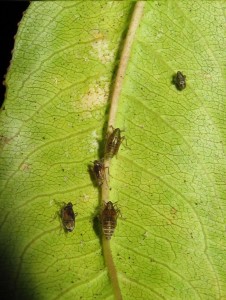 Species in the planthopper genus Nesosydne (Delphacidae: Hempitera) are distributed throughout islands in the eastern Pacific. Eighty-two of its described species, the majority of its diversity, are endemic to the Hawaiian Islands. Like other members of the Delphacidae, species of Nesosydne are highly host specific, feeding on phloem, and mating and ovipositing on only one or a few closely related host plant species. The vast majority of the species in the Hawaiian Nesosydne are specialized to different host plant species – representing a total of 28 different plant families. Recent studies suggest that initial divergence within species in the Hawaiian Nesosydne radiation is decoupled from the ecological diversification: Species within the lineage first fracture into multiple genetic pools under the influence of geographic isolation. Shifts in sexual signals among populations subsequently develop to allow reproductive isolation.
Species in the planthopper genus Nesosydne (Delphacidae: Hempitera) are distributed throughout islands in the eastern Pacific. Eighty-two of its described species, the majority of its diversity, are endemic to the Hawaiian Islands. Like other members of the Delphacidae, species of Nesosydne are highly host specific, feeding on phloem, and mating and ovipositing on only one or a few closely related host plant species. The vast majority of the species in the Hawaiian Nesosydne are specialized to different host plant species – representing a total of 28 different plant families. Recent studies suggest that initial divergence within species in the Hawaiian Nesosydne radiation is decoupled from the ecological diversification: Species within the lineage first fracture into multiple genetic pools under the influence of geographic isolation. Shifts in sexual signals among populations subsequently develop to allow reproductive isolation.
